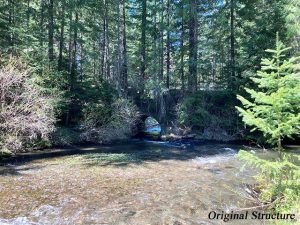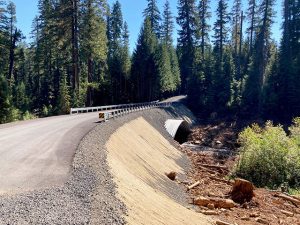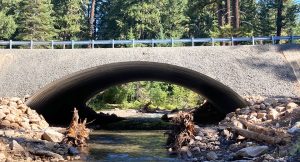By: Contech Engineered Solutions

PacifiCorp Hydro needed to upgrade a United States Forest Service (USFS) road that they regularly used through the Umpqua National Forest in southwest Oregon. The upgrade included removing fish barriers on Imnaha Creek and Big Ben Creek. The USFS provided AECOM with minimum span requirements for the new streambed simulations and the minimum end areas for hydraulics. AECOM then designed preliminary shapes with minimum spans and maximum rises for structural plate arches and designed the foundations to be set below scour elevation.
The new structure was designed to serve as a Aquatic Organism Passage (AOP), allowing fish and other aquatic organisms to migrate and swim freely upstream and downstream through or beneath human infrastructure. These structures are ecologically important in providing passage to all native aquatic and riparian species dependent on passage through road-stream crossings and for all life stages of those species, particularly to provide resilience to climate change stresses to these populations. The Umpqua National Forest is home to world-class fisheries, including steelhead, Chinook salmon, and many other species of fish.
Contech then designed a custom deep corrugated structural plate arches to meet the minimum dimensional requirements and the structural needs of the roadway. Contech’s soultion was  generically equivalent to AASHTO M 167 Deep Corrugated Steel Structural Plate and Contech followed the AASHTO design methodology and utilized finite element analysis to gage the custom arches to handle HL-93 live loads with 3 feet of minimum cover.
generically equivalent to AASHTO M 167 Deep Corrugated Steel Structural Plate and Contech followed the AASHTO design methodology and utilized finite element analysis to gage the custom arches to handle HL-93 live loads with 3 feet of minimum cover.
The USFS and AECOM were both quite familiar with steel structural plate being used for buried bridges over fish bearing streams as the product is used regularly in National Forests across the country, but the Imnaha Creek structure is by far the largest span that either has dealt with-or installed on past projects. The Imnaha Creek 2 radius arch has a span of 63’ 8” and a rise of 21’ 2”. All the plates consist of 3 gage high strength steel and the structure meets all the requirements of AASHTO M 167.

Both AASHTO and Contech recommend that flexible structures of this size be constantly shape monitored while being backfilled. Contech supplied a shape monitor technician who took initial measurements of the structure prior to backfilling. After the structure was verified to be within shape tolerance, the backfill sequence took place. The shape monitor technician took regular measurements and recorded compaction test results until the fill height above the structure reached minimum cover elevations. The structure stayed within tolerances and the compaction tests all met the minimum allowable percentages.
Weekly Brothers out of Roseburg, Oregon provided the low bid and was awarded the contract for the roadway upgrade. They selected Contech as their material supplier and submitted Contech’s design for approval. The Contech designs were approved and an order was placed on Contech’s Mansfield, Texas manufacturing facility.
In the end the project was a success and came in under budget. The local salmon can now travel up stream without a barrier above their natural streambed.